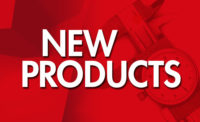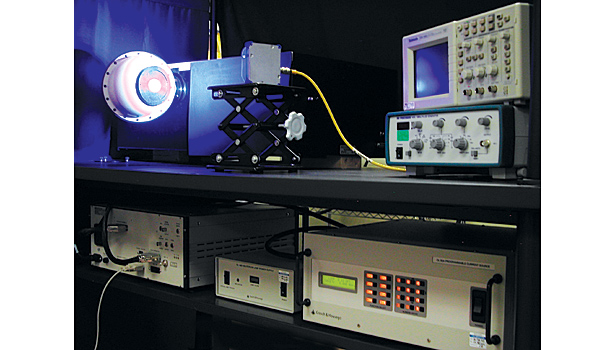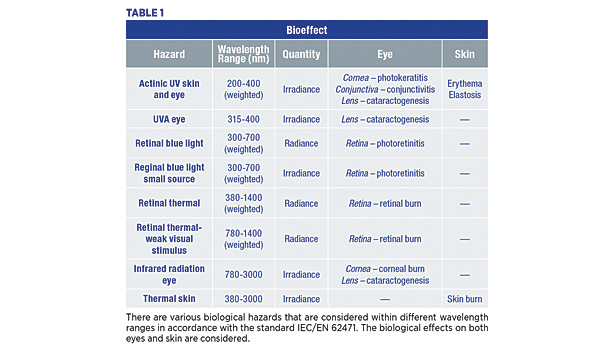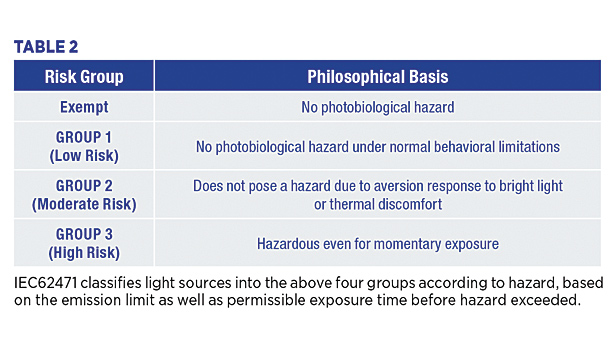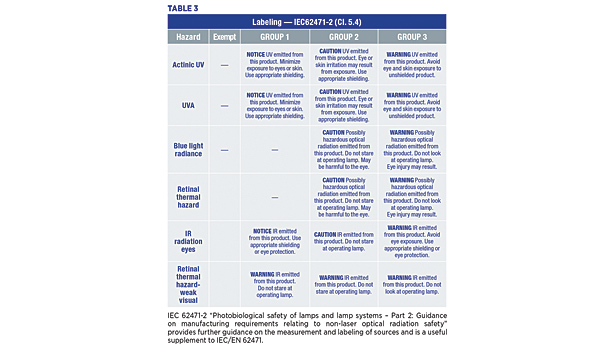Are Your LED Lights Safe?
WHITE LEDS ARE WIDELY USED IN INDUSTRIAL AND ARCHITECTURAL LIGHTING APPLICATIONS.












Manufacturers of products containing light-emitting diodes (LEDs) know that governments around the world require their products to be tested to guarantee that ultraviolet (UV) and infrared (IR) light output does not exceed safety levels outlined in international standard IEC62471. What they may not know is that products bearing CE, UL, CCC, or other national marks that do not have documented proof of IEC62471 compliance can be confiscated—even from customer installations—excluded from sale within the country, and the manufacturer fined.
Until the last decade, LED lights emitted powers that were too low to raise safety concerns. OEMs that used lasers, coherent light sources offering significantly more power, were accustomed to testing, documenting, and certifying their devices to a specific hazard category that dictated safe work practices for nearby technicians. But in the case of LEDs, an internationally recognized safety standard based on wavelength and emission power wasn’t required.
TECH TIPSEurope, Canada, and parts of Asia require that all lights be tested and documented to the IEC62471 standard.
Unfortunately, many manufacturers are unaware of Believing their products comply with all relevant standards, these OEMs routinely apply CE marks for products to be sold in Europe, for example. |
Then came the telecom boom of the 1990s, which lead to significant development in LED solid-state architectures with an eye towards driver fiber lasers used in optical fiber communications. As a result, LEDs benefited from exponential performance improvements. As power levels increased, more lighting applications turned to solid state illumination thanks to better efficiency and lower operating costs of LEDs compared to incandescent and gas-discharge lamps.
Also, because LED lights are made of a monolithic semiconductor material, they are inherently more rugged than filament- or ballast-based lights, which have endeared LED lights to industrial markets where uptime is a primary concern. Finally, LED lights also can be designed to generate virtually any wavelength or color of light from the UV through the IR spectral band.
White, UV and IR LEDs
Today, white LEDs are widely used in industrial and architectural lighting applications. Most white LED lights start as a blue LED with additional phosphor coating to create a broadband white light source. This has led to the development of brighter and brighter blue LEDs, which also emit some amount of UV light because blue light borders UV light on the electromagnetic spectrum.
Unfortunately, as the white LED becomes more prevalent, it increased the danger of damage to human eyes. Just as children are taught in school not to look directly into the sun, above certain luminosities, UV, visible, and IR light all pose photobiological threats to eyes.
In response, the International Electrotechnical Commission (IEC), with input from IEEE and other industrial groups, developed an international standard – IEC62471 “Photobiological Safety of Lamps and Lamp Systems” – in 2009 to protect people from photobiological damage caused by LED light. The standard requires that all lamp designs, including LED and all luminaires, have their output tested and documented from 200 nm to 3000 nm to prove the light does not exceed safety output thresholds defined by a certain luminosity at a given distance. Based on these tests, LED lights are classified within one of four risk categories and must be labeled accordingly (see tables).
Based on tests documented in the IEC62471 standard, LED lights are classified within one of four risk categories and must be labeled accordingly. There are various biological hazards that are considered within different wavelength ranges in accordance with the standard IEC/EN 62471. The biological effects on both the eyes and skin are tabulated in Table 1. Sources are classified into four groups according to hazard, based on the emission limit and permissible exposure time before the hazard is exceeded (Table 2). To determine the risk group of a source, its spectral irradiance or radiance has to be measured at a specified distance, weighted with spectra and maximum allowed exposure time, which is compared to different exposure limits (Table 3).
Today, Europe, Canada, and parts of Asia require that all lights be tested and documented to the IEC62471 standard. Unfortunately, many manufacturers are unaware of this requirement. Believing their products comply with all relevant standards, these OEMs routinely apply CE marks for products to be sold in Europe, for example. However, should a problem or lawsuit arise, and the OEM does not have certified test documents, these products will be removed and prohibited from sale and raise the potential of fines, regardless of whether the product actually complies with IEC62471. In other words, testing and documentation are a requirement, not an option when it comes to “safe for sale” marks in most developed markets around the world.
While many countries require compliance with IEC62471, each country has the right to alter it as necessary. To help global manufacturers comply with the different requirements, the International Electrotechnical Commission for Electrical Equipment Safety (IECEE) developed a Certification Body (CB) Scheme. The CB Scheme allows for mutual recognition of LED test reports and IEC62471 compliance certificates among 53 different countries, including Argentina, Australia, Austria, Belarus, Belgium, Brazil, Canada, China, Czech Republic, Denmark, Finland, France, Germany, Greece, Hungary, India, Indonesia, Ireland, Israel, Italy, Japan, Republic of Korea, Kenya, Malaysia, Mexico, Netherlands, New Zealand, Norway, Poland, Portugal, Romania, Russian Federation, Serbia and Montenegro, Singapore, Slovakia, Slovenia, South Africa, Spain, Sweden, Switzerland, Thailand, Turkey, Ukraine, United Kingdom, and the U.S.
For companies interested in having their lights tested to the IEC62471 specification, there are third party certification groups as well as some OEMs willing to perform the service. A common laboratory testing setup would include items such as a Spectroradiometric system consisting of an OL 750-M-D double monochromator with integrating sphere, including germanium, lead sulfide, and silicon high-sensitivity detectors for performing highly accurate optical radiation measurements. Customers buying IEC-compliant lights should make sure that their vendor’s test equipment is regularly calibrated and verified to meet the minimum accuracy requirements published in CTL Decision Sheet 251B — Measurement Accuracy.
What IEC62471 compliance means to you, the LED customer, is that any product or system you design using IEC62471-compliant LED lights is safe to operate and sell in any country around the world. While not every company around the world is aware of the need for IEC62471 compliance, large companies and governmental agencies are well aware of the need to comply with IEC safety standards.
Whether customers or regulators are aware of the standard or not, ignorance is not a legal defense. Make sure you’re not blindsided by IEC62471 violations.
Looking for a reprint of this article?
From high-res PDFs to custom plaques, order your copy today!



